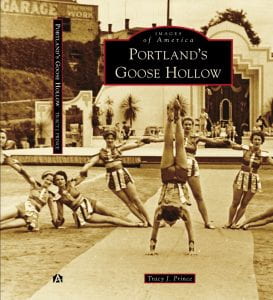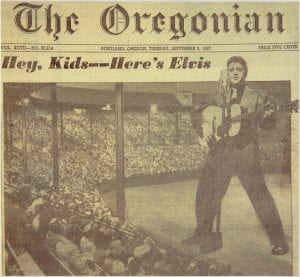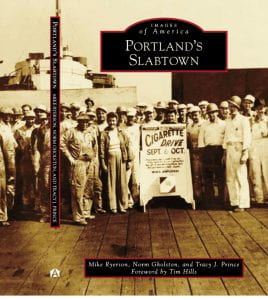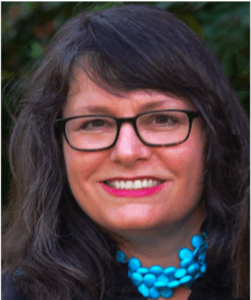Dr. Tracy J. Prince shares how she takes advantage of the sources available on Historic Oregon Newspapers to uncover forgotten histories of Portland.
Can you tell us a little about your publication(s) and yourself?
I’m a Professor at Portland State University’s American Indian Teacher Program (in the College of Education) and the author of Portland’s Goose Hollow and Culture Wars in British Literature: Multiculturalism and National Identity and co-author of Notable Women of Portland and Portland’s Slabtown. Fellowships and teaching opportunities have taken me to Malta (as a Fulbright Senior Specialist), France, England, Canada, South Africa, Australia, and Turkey, but Oregon has been my home since 2001.
What interested you in this topic?
All of my research has focused on what has been overlooked in previous histories and trying to uncover and tell those stories in my books. Growing up in the South, in poverty, in a family that had hidden most of its racial history—I’ve always had a lot of questions about race, gender, and social equity issues in history. In my three Oregon history books, I dove deep, trying to understand the lives of women, blue-collar immigrants, and people of color—stories that weren’t considered significant in earlier histories of Portland.
What resources did you use for your research?
The Historic Oregon Newspapers online was my most important source. I also researched at many archives, including: Oregon Historical Society, City of Portland Archives, Portland State University Archives, OSU and U of O Archives, State of Oregon Archives, Oregon Jewish Museum archives, Portland Art Museum, and many others.
What did you use in Historic Oregon Newspapers online? How did you use the site and which titles were useful to you?
I focused my search on Portland resources including: The West Shore, Oregon Daily Journal, Oregonian, Morning Oregonian, and Sunday Oregonian.
Historic Oregon Newspapers online was life-changing for my research! Back in the olden days, in 1997, when I received my Ph.D. from the University of Nebraska, research had to be conducted in the library, holding a book, journal, or newspaper in my hand or scrolling through microfiche or microfilm. The miracle of Historic Oregon Newspapers online was being able to do key-word searches in historic newspapers to try to understand what was happening in Portland in the 1840s to 1910s. While writing most of my books, my children were small, so I did a lot of my research online, after I put my kids to bed. Using Historic Oregon Newspapers online, I read most mentions of the word “Indian” from the 1840s-1870s in Portland. I looked for mentions of Chinese vegetable gardens and black pioneers and women pioneers.
My three Portland history books could not have happened without the fantastic Oregon Digital Newspapers resource! Here are some of the discoveries I made in my digital newspapers research:
 My Portland’s Goose Hollow book (2011, Arcadia), explores the history of Native American, Chinese, Irish, German, and Jewish residents of one of Portland’s oldest neighborhoods and the now-buried Tanner Creek that carved out the gulch giving Goose Hollow its name.
My Portland’s Goose Hollow book (2011, Arcadia), explores the history of Native American, Chinese, Irish, German, and Jewish residents of one of Portland’s oldest neighborhoods and the now-buried Tanner Creek that carved out the gulch giving Goose Hollow its name.
Thanks to Historic Oregon Newspapers online, I was able to uncover lots of forgotten information about Tanner Creek and the Tanner Creek Gulch before the creek was buried; how the gulch was infilled and turned into sports fields for the Multnomah Athletic Club (now Providence Park-where Elvis once performed) and Lincoln High School; and the hundreds of Chinese gardeners living and working in Goose Hollow.
My two most surprising discoveries were finding digital newspaper articles about Native Americans living near the Chinese gardeners in the gulch and finding the original 1870s Oregonian article “A War About Geese” describing the incident where Goose Hollow first got its name after women fought over geese and assaulted a police officer who responded to the ruckus. This article has never been seen in any other Portland history book and took hundreds of hours of research to find. These Native American and Goose Hollow origin stories would’ve been impossible to find without the fantastic resource of Oregon’s digitized newspapers.
 My Portland’s Slabtown book (2013, Arcadia, co-authored) covers northwest Portland (from the Willamette River to the Tualatin Mountains), much of which was once called Slabtown. Thanks to searching Historic Oregon Newspapers online, I was able to uncover a forgotten Native-American village in northwest Portland in the long-forgotten and infilled Johnson Creek Gulch. This was a stunning find, as I read an Oregonian interview with a pioneer who was reminiscing about a Native American village and sweat lodge near NW 19th and Overton. I just about fell over as I read the newspaper article online. Other digitized articles helped me uncover much more extensive Chinese vegetable gardens than previously known; stories of Chinese and Native people speaking Chinook Jargon (also called Chinook Wawa) to each other; stories of Native Americans returning annually to northwest Portland’s Wallace Park for seasonal trading encampments (until at least the 1930s); and many stories about the buried creeks, lakes, and gulches of northwest Portland. Most of this incredible history would remain unknown today if Oregon’s Digitized Newspaper project did not exist.
My Portland’s Slabtown book (2013, Arcadia, co-authored) covers northwest Portland (from the Willamette River to the Tualatin Mountains), much of which was once called Slabtown. Thanks to searching Historic Oregon Newspapers online, I was able to uncover a forgotten Native-American village in northwest Portland in the long-forgotten and infilled Johnson Creek Gulch. This was a stunning find, as I read an Oregonian interview with a pioneer who was reminiscing about a Native American village and sweat lodge near NW 19th and Overton. I just about fell over as I read the newspaper article online. Other digitized articles helped me uncover much more extensive Chinese vegetable gardens than previously known; stories of Chinese and Native people speaking Chinook Jargon (also called Chinook Wawa) to each other; stories of Native Americans returning annually to northwest Portland’s Wallace Park for seasonal trading encampments (until at least the 1930s); and many stories about the buried creeks, lakes, and gulches of northwest Portland. Most of this incredible history would remain unknown today if Oregon’s Digitized Newspaper project did not exist.
 In my Notable Women of Portland book (2017, Arcadia, co-authored with Zadie Schaffer), my research uncovers the almost completely forgotten presence of Native Americans in Portland history and other complex ethnic and blue-collar stories that are often overlooked, with chapters on Native and pioneer women, Progressive Era women, women of WWI, WWII, and post-war, women in the arts and women in politics. Oregon’s Digitized Newspapers allowed me to:
In my Notable Women of Portland book (2017, Arcadia, co-authored with Zadie Schaffer), my research uncovers the almost completely forgotten presence of Native Americans in Portland history and other complex ethnic and blue-collar stories that are often overlooked, with chapters on Native and pioneer women, Progressive Era women, women of WWI, WWII, and post-war, women in the arts and women in politics. Oregon’s Digitized Newspapers allowed me to:
-Uncover a more complex history of Native American women in early Portland than any other historian has covered (including the pervasive use of Chinook Jargon).
-Correct the record and find more information on Black pioneer Sydna Francis’s family. She wrote for Frederick Douglass’s newspaper and was prominent in New York abolitionist activism before moving to Portland in 1851. I found advertisements for the store on Front Street that she and her husband ran. Oregon histories refer to her brother-in-law (a Portland merchant) by the incorrect name of O.B. Francis. Digitized newspapers allowed me to find an 1852 Oregonian ad from his store to prove that his name was I.B. Francis.
-Find photos of Oregon women in WWI and WWII, including newspaper articles about women heading off to join the Yeomanettes or to be a Red Cross nurse at the Presidio.
-Learn more about women working in Portland’s shipbuilding industry
-Find a previously unknown illustration of the Oregon Camera Club where Lily White and Sarah Ladd were prominent members.
-Find an image and biography of Capt. Minnie Hill, the only woman riverboat captain west of the Mississippi.
-Find an article where Tolstoi praised the metaphysical writings of Lucy Mallory.
Where can we purchase/access your work?
The books are available at Powells, most Portland bookstores, many libraries, Amazon, etc.
What’s your next project?
I’m constantly researching for these future books. For all but the last one, I’m again relying heavily on Historic Oregon Newspapers online:
-Native American Art of Oregon
-The Forgotten Native American History of Portland
-Chinese Vegetable Gardens of the West Coast
-Might Oughta Keep Singin’ (about race and music in the American South told through four generations in Arkansas).
Meeting a kindred soul:
At every talk I give around the state, I mention how grateful I am to have the Historic Oregon Newspapers online resource, how it has allowed me to uncover a much more multicultural history than is ever taught in histories of Portland, and how researching online allowed me to research at home when I had two small children and couldn’t’ve spent hours at the library. I also tell people what a wonderful resource this is for ancestry research. After one of my talks, a woman came toward me with a big smile and told me that she couldn’t believe she was in the audience as I told this story, since she and her late husband David Arlington were some of the early donors to the effort to digitize Oregon’s newspapers. I was so excited to shake Andrea Arlington’s hand and thank her, to tell her how much their contributions meant to my research, to tell her how my research on Oregon’s multicultural history is now being used in many public schools, to tell her how life-changing this resource has been to my work! What a wonderful gift to give generations of researchers, to help tell the complex histories of Oregon that earlier historians didn’t think to focus on. I encourage folks to dig in and see what you can uncover.


Leave a Reply